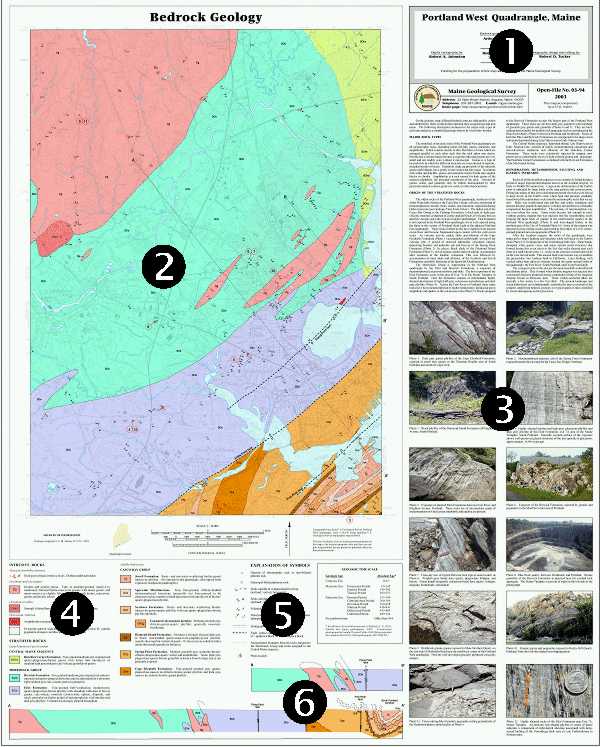DACF Home → Bureaus & Programs → Maine Geological Survey → Using Geologic Maps → Bedrock Geology Maps → Detailed Bedrock Geology Map
Detailed Bedrock Geology Maps
Typical format of information shown on Detailed Bedrock Geology Maps:
| Although there may be variable amounts of detail and types of geologic features shown on different bedrock maps, the basic elements are the same from map to map. This colored map shows an example of a 7' quadrangle map (1:24,000 scale) published after 1997. Numbers indicate portions of the map explained below. |

| 1 | Title block - Gives the name of the U.S.G.S. quadrangle, the name of the geologist(s) who compiled and interpreted the map, and the date of publication. |
| 2 | Geologic map - Displays all the bedrock geologic information, including observed bedrock locations and individual data points, as well as the interpreted distribution of rock units and the nature of their contacts. Each rock unit is identified by color and by a letter symbol that corresponds to its description in the Explanation of Units (part 4 below). Information along the lower edge of the map includes the sources of geologic information and the map scale. |
| 3 | Sidebar - Gives a narrative description of noteworthy aspects of the bedrock in this map area. May be accompanied by photographs of representative or important bedrock outcrops. |
| 4 | Explanation of units - Describes the types of rocks included in each rock unit on the map. Color and letter symbol in the small box corresponds with the map. Some rock units may be uniform, while other units may be internally complex and variable. Units are listed in groups according to their origin, and within groups are listed by age from youngest at the top to oldest at the bottom. |
| 5 | Explanation of symbols - Describes the observed bedrock characteristics that are represented on the map by various symbols. |
| 6 | Geologic cross sections - Represents the author's prediction of what a vertical slice through the bedrock would look like. Cross sections are constructed geometrically from the mapped pattern of rock units on the ground, combined with measured orientations of features in the bedrock, and an understanding of geologic principles. In Maine, deep drill cores are not available to verify these cross sections. |
Last updated on April 25, 2012